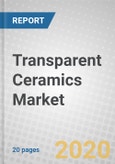Report Includes:
- An overview of the latest technological advances in processing, materials, and applications of transparent (polycrystalline) ceramics
- Analyses of global market trends with data from 2018 to 2019, and projections of compound annual growth rates (CAGRs) through 2024
- Assessment of market opportunities for alumina, yttrium aluminum garnets (YAG), magnesium aluminate, fluorides, selenides, and sulfides from the strong growth for the coming five years
- A timeline of some major accomplishments for the transparent ceramics
- Discussion of future trend and perspectives, as well as some important issues like optical, mechanical and thermal properties and regulatory challenges, of transparent ceramic materials
Transparent ceramics are defined as inorganic, nonmetallic polycrystalline materials that transmit light with wavelengths in the visible electromagnetic spectrum. Ceramic is considered transparent when its real in-line transmission (RIT) is 60% or higher at wavelengths between 300 nanometers (nm) and 800 nm in samples that have a minimum thickness of 0.8 mm. In recent years, the definition has expanded to include materials that also allow light with wavelengths in the ultraviolet and infrared regions of the spectrum to pass through.
Table of Contents
Chapter 1 Transparent Ceramics: Emerging Opportunities
List of Tables
List of Figures
Samples

LOADING...








